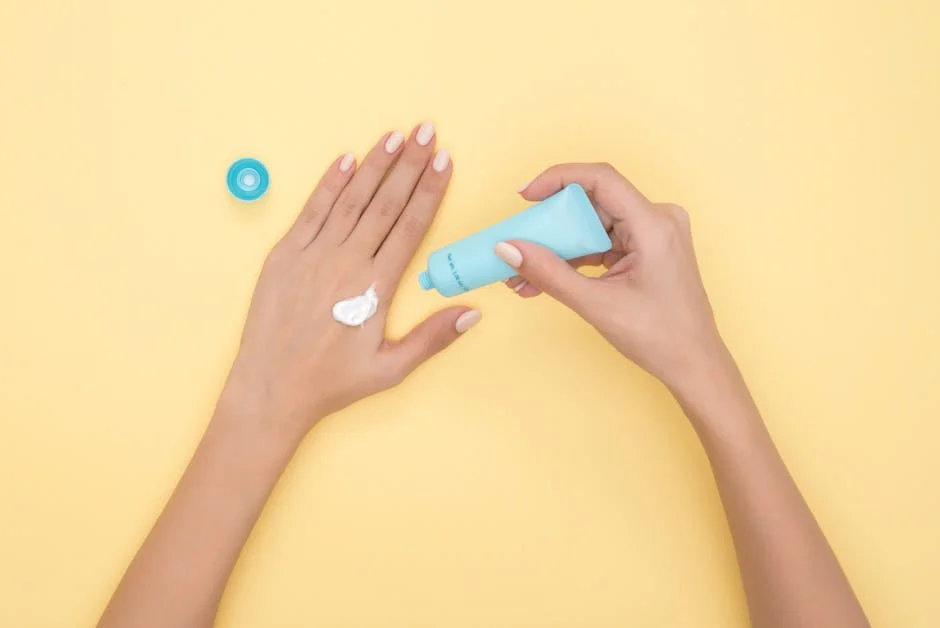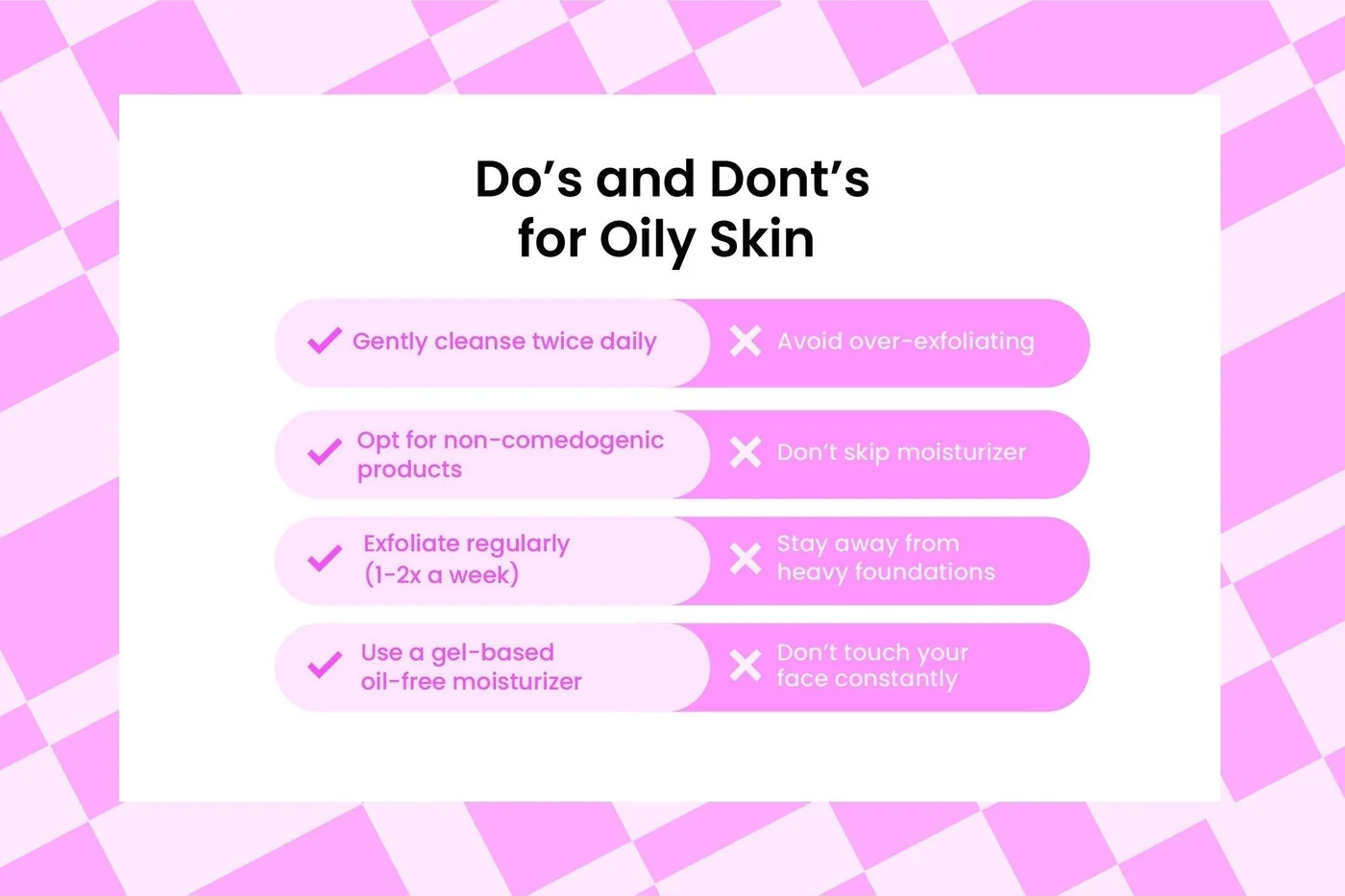Managing oily skin requires a balanced skincare routine that controls excess oil while maintaining hydration. This guide breaks down essential steps—from cleansing and toning to moisturizing and sun protection—using ingredients like salicylic acid and niacinamide, proven to help reduce shine and clear pores. Whether you’re new to skincare or refining your regimen, a consistent skin care routine is your best ally. These practical tips for oily skin will keep your complexion fresh and healthy.
Understanding Oily Skin
If you feel like you’re constantly reaching for blotting papers by midday, you’re not alone. Oily skin is caused by overactive sebaceous glands producing too much sebum—the natural oil that protects and hydrates our skin. While sebum is essential, an excess of it can lead to that persistent shine, especially in the T-zone (forehead, nose, and chin).
This overproduction often results in a few common frustrations:
- Enlarged, visible pores
- A greasy or shiny appearance
- A tendency for blackheads and acne breakouts
The goal isn’t to completely strip your skin of oil, which can actually make things worse. Instead, the focus is on finding a healthy balance, and that’s exactly what a dedicated routine can do.
Essential Skincare Routine Steps for Oily Skin
A consistent daily routine is the foundation for managing oily skin. Think of it as a simple commitment you make to your skin every morning and night. The core steps are straightforward and designed to work together to control oil, prevent breakouts, and keep your skin hydrated.

Here are the five essential steps for both your AM and PM regimen.
Step 1 – Cleansing
The first step is always to wash away the excess oil, dirt, and impurities from the day. For oily skin, a gentle foaming cleanser or a gel-based formula is your best friend. Look for products containing ingredients like salicylic acid or a low concentration of benzoyl peroxide, as they help to exfoliate inside the pores, preventing them from getting clogged.
It’s tempting to scrub your face until it feels squeaky clean, but that can be counterproductive. Over-washing strips the skin’s moisture barrier, signaling it to produce even more oil. Stick to cleansing twice a day—once in the morning and once at night.
Step 2 – Using Toner
Toners have come a long way from the harsh, alcohol-based formulas of the past. Today’s toners for oily skin are designed to restore your skin’s pH balance after cleansing, remove any last traces of impurities, and tighten the appearance of pores.
An alcohol-free toner with ingredients like witch hazel or a low dose of salicylic acid can help control shine without causing dryness. Just a few swipes with a cotton pad after cleansing preps your skin to better absorb the treatments that follow.
Step 3 – Targeted Treatments
This is where you can really customize your routine to address specific concerns. Serums are lightweight, concentrated formulas that deliver a potent dose of active ingredients directly to your skin.
For oily and acne-prone skin, a few ingredients are particularly effective:
- Niacinamide: A true powerhouse for regulating sebum production and minimizing the appearance of pores.
- Retinol: Best used in your nighttime skincare routine, retinol helps accelerate cell turnover to keep pores clear and improve skin texture over time.
- Vitamin C: An antioxidant that’s great for your morning routine. It helps protect the skin from environmental damage and can brighten post-acne marks.
Step 4 – Moisturizing
It’s one of the biggest myths in skincare: that oily skin doesn’t need moisturizer. In reality, skipping this step can make your skin even oilier. When your skin becomes dehydrated, it compensates by producing more sebum, leading to more shine and potential breakouts.
The key is choosing the right formula. Look for a moisturizer that is lightweight, oil-free, and non-comedogenic (meaning it won’t clog your pores). Gel, lotion, or water-based creams with hydrating ingredients like hyaluronic acid and glycerin are excellent choices. They provide the necessary moisture without feeling heavy or greasy.
Step 5 – Sun Protection
Sunscreen is a non-negotiable step for everyone, every single day. For those with oily skin, the thought of adding another layer can be daunting, but modern formulas are designed with you in mind. Sun damage not only increases health risks but can also thicken the outer layer of the skin, leading to clogged pores.
Choose a mattifying or gel-based sunscreen with an SPF of 30 or higher. These formulas provide essential UV protection without adding extra shine or contributing to breakouts.

Weekly Skincare Additions for Oily Skin
Beyond your daily routine, incorporating a couple of weekly treatments can significantly boost your results. Think of these as a reset for your skin.
Chemical vs Physical Exfoliation
Exfoliation is crucial for removing the dead skin cells that can clog pores and lead to breakouts. While physical scrubs (with beads or grains) exist, chemical exfoliants are often a gentler and more effective choice for oily skin.
- BHAs (Beta Hydroxy Acids): Salicylic acid is the go-to BHA. It’s oil-soluble, meaning it can penetrate deep into your pores to dissolve sebum and dead skin.
- AHAs (Alpha Hydroxy Acids): Glycolic acid is a popular AHA that works on the skin’s surface to brighten and smooth texture.
Start by incorporating a chemical exfoliant just 1-2 times per week to avoid irritation.
Masking Benefits
A weekly mask is a great way to deep clean your pores and give your skin a little extra care.
- Clay Masks: Masks with bentonite or kaolin clay are fantastic for absorbing excess oil and pulling impurities out of your pores.
- Soothing Masks: If your skin feels irritated or inflamed, a calming mask with ingredients like aloe vera or green tea can help reduce redness and provide gentle hydration.
Do’s and Don’ts for Oily Skin Care
Navigating oily skin care is all about smart habits. Here’s a quick guide:

Do:
- Be consistent with your morning and evening routine.
- Look for “non-comedogenic” and “oil-free” on labels.
- Blot excess oil during the day with blotting papers instead of adding more powder.
- Stay hydrated by drinking plenty of water.
Don’t:
- Over-wash or scrub your face too aggressively.
- Skip moisturizer or sunscreen.
- Use heavy, pore-clogging creams or oils.
- Touch your face frequently, as this can transfer dirt and bacteria.
Common Mistakes to Avoid with Oily Skin
Sometimes, our best intentions can backfire. Over-cleansing, for example, strips your natural moisture barrier and triggers rebound oil production. Using harsh, alcohol-laden products can irritate the skin, leading to inflammation and breakouts. Similarly, thinking that a heavy cream will “fix” dryness can end up clogging pores. The key is to be gentle and focus on balance, not elimination. If you have oily skin in some areas and dry patches in others, you might benefit from learning about a skincare routine for combination skin.
Recommended Ingredients and Products for Oily Skin
When you’re scanning product labels, here are the hero ingredients to look for:
- Salicylic Acid: For deep-cleaning pores.
- Niacinamide: To regulate oil and reduce the appearance of pores.
- Retinol: For promoting cell turnover and preventing acne.
- Glycolic Acid: To exfoliate the surface and improve skin tone.
- Hyaluronic Acid: For lightweight, oil-free hydration.
- Witch Hazel: An effective astringent to help control shine (in alcohol-free formulas).
- Tea Tree Oil: For its natural antibacterial properties to spot-treat breakouts.
How Lifestyle Affects Oily Skin
What you do every day matters. While skincare is crucial, your lifestyle choices also play a part. Diets high in sugar and dairy have been linked to increased sebum production in some people. Stress can also trigger hormonal fluctuations that lead to more oil and breakouts. Staying hydrated and getting enough sleep are foundational tips for healthy skin that support any topical routine. It’s all connected!

Finding the right balance for oily skin is a journey, but it’s one that’s well worth it. Consistency is more important than perfection. By following these steps and listening to your skin, you can control shine, prevent breakouts, and achieve a complexion that feels healthy and comfortable. For more wellness and skincare insights, feel free to explore more content here at www.notonetype.org.


You may also like this
Best Skin Care Routine 2025: Step-by-Step Guide
A great skin care routine is the foundation of healthy, radiant skin. Whether you’re new...
Nov
Complete Guide to Building a Skincare Routine for Dry Skin
Dealing with dry skin can feel like a constant battle. That tight, uncomfortable feeling, the...
Nov
Skin Routine for Teens: A Simple Guide to Healthy Skin
Developing a simple, effective skin routine for teens is one of the best things you...
Nov
Balanced Skincare Routine for Combination Skin
Finding the right skin care routine for combination skin means balancing oily zones with dry...
Nov
Best Nighttime Skincare Routine for Oily Skin in 2025
If you have oily skin, the end of the day might feel like a race...
Nov
Skincare for Over 40s: Best Routines, Products & Ingredients for Radiant Mature Skin
Hello, lovely people! Let’s talk about something that feels like it happened overnight: waking up...
Nov